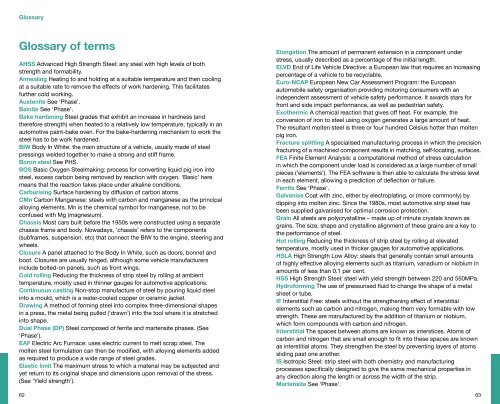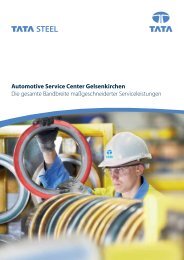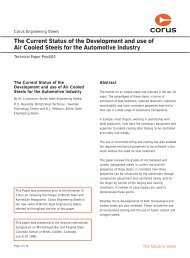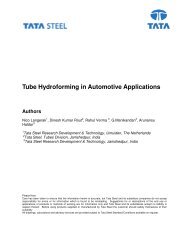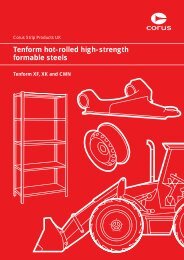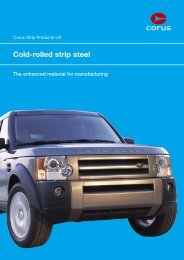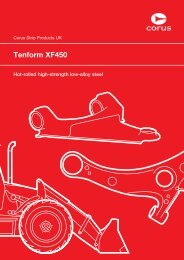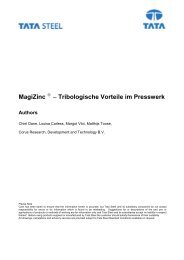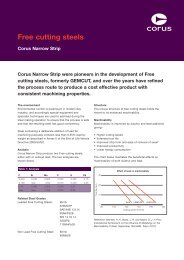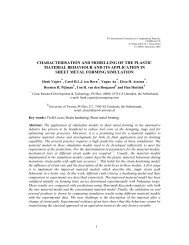Glossary of terms - Tata Steel in the automotive industry
Glossary of terms - Tata Steel in the automotive industry
Glossary of terms - Tata Steel in the automotive industry
You also want an ePaper? Increase the reach of your titles
YUMPU automatically turns print PDFs into web optimized ePapers that Google loves.
<strong>Glossary</strong><br />
<strong>Glossary</strong> <strong>of</strong> <strong>terms</strong><br />
AHSS Advanced High Strength <strong>Steel</strong>: any steel with high levels <strong>of</strong> both<br />
strength and formability.<br />
Anneal<strong>in</strong>g Heat<strong>in</strong>g to and hold<strong>in</strong>g at a suitable temperature and <strong>the</strong>n cool<strong>in</strong>g<br />
at a suitable rate to remove <strong>the</strong> effects <strong>of</strong> work harden<strong>in</strong>g. This facilitates<br />
fur<strong>the</strong>r cold work<strong>in</strong>g.<br />
Austenite See ‘Phase’.<br />
Ba<strong>in</strong>ite See ‘Phase’.<br />
Bake harden<strong>in</strong>g <strong>Steel</strong> grades that exhibit an <strong>in</strong>crease <strong>in</strong> hardness (and<br />
<strong>the</strong>refore strength) when heated to a relatively low temperature, typically <strong>in</strong> an<br />
<strong>automotive</strong> pa<strong>in</strong>t-bake oven. For <strong>the</strong> bake-harden<strong>in</strong>g mechanism to work <strong>the</strong><br />
steel has to be work hardened.<br />
BIW Body In White: <strong>the</strong> ma<strong>in</strong> structure <strong>of</strong> a vehicle, usually made <strong>of</strong> steel<br />
press<strong>in</strong>gs welded toge<strong>the</strong>r to make a strong and stiff frame.<br />
Boron steel See PHS.<br />
BOS Basic Oxygen <strong>Steel</strong>mak<strong>in</strong>g: process for convert<strong>in</strong>g liquid pig iron <strong>in</strong>to<br />
steel, excess carbon be<strong>in</strong>g removed by reaction with oxygen. ‘Basic’ here<br />
means that <strong>the</strong> reaction takes place under alkal<strong>in</strong>e conditions.<br />
Carburis<strong>in</strong>g Surface harden<strong>in</strong>g by diffusion <strong>of</strong> carbon atoms.<br />
CMn Carbon Manganese: steels with carbon and manganese as <strong>the</strong> pr<strong>in</strong>cipal<br />
alloy<strong>in</strong>g elements. Mn is <strong>the</strong> chemical symbol for manganese, not to be<br />
confused with Mg (magnesium).<br />
Chassis Most cars built before <strong>the</strong> 1950s were constructed us<strong>in</strong>g a separate<br />
chassis frame and body. Nowadays, ‘chassis’ refers to <strong>the</strong> components<br />
(subframes, suspension, etc) that connect <strong>the</strong> BIW to <strong>the</strong> eng<strong>in</strong>e, steer<strong>in</strong>g and<br />
wheels.<br />
Closure A panel attached to <strong>the</strong> Body In White, such as doors, bonnet and<br />
boot. Closures are usually h<strong>in</strong>ged, although some vehicle manufacturers<br />
<strong>in</strong>clude bolted-on panels, such as front w<strong>in</strong>gs.<br />
Cold roll<strong>in</strong>g Reduc<strong>in</strong>g <strong>the</strong> thickness <strong>of</strong> strip steel by roll<strong>in</strong>g at ambient<br />
temperature, mostly used <strong>in</strong> th<strong>in</strong>ner gauges for <strong>automotive</strong> applications.<br />
Cont<strong>in</strong>uous cast<strong>in</strong>g Non-stop manufacture <strong>of</strong> steel by pour<strong>in</strong>g liquid steel<br />
<strong>in</strong>to a mould, which is a water-cooled copper or ceramic jacket.<br />
Draw<strong>in</strong>g A method <strong>of</strong> form<strong>in</strong>g steel <strong>in</strong>to complex three-dimensional shapes<br />
<strong>in</strong> a press, <strong>the</strong> metal be<strong>in</strong>g pulled (‘drawn’) <strong>in</strong>to <strong>the</strong> tool where it is stretched<br />
<strong>in</strong>to shape.<br />
Dual Phase (DP) <strong>Steel</strong> composed <strong>of</strong> ferrite and martensite phases. (See<br />
‘Phase’).<br />
EAF Electric Arc Furnace: uses electric current to melt scrap steel. The<br />
molten steel formulation can <strong>the</strong>n be modified, with alloy<strong>in</strong>g elements added<br />
as required to produce a wide range <strong>of</strong> steel grades.<br />
Elastic limit The maximum stress to which a material may be subjected and<br />
yet return to its orig<strong>in</strong>al shape and dimensions upon removal <strong>of</strong> <strong>the</strong> stress.<br />
(See ‘Yield strength’).<br />
62<br />
Elongation The amount <strong>of</strong> permanent extension <strong>in</strong> a component under<br />
stress, usually described as a percentage <strong>of</strong> <strong>the</strong> <strong>in</strong>itial length.<br />
ELVD End <strong>of</strong> Life Vehicle Directive: a European law that requires an <strong>in</strong>creas<strong>in</strong>g<br />
percentage <strong>of</strong> a vehicle to be recyclable.<br />
Euro-NCAP European New Car Assessment Program: <strong>the</strong> European<br />
automobile safety organisation provid<strong>in</strong>g motor<strong>in</strong>g consumers with an<br />
<strong>in</strong>dependent assessment <strong>of</strong> vehicle safety performance. It awards stars for<br />
front and side impact performance, as well as pedestrian safety.<br />
Exo<strong>the</strong>rmic A chemical reaction that gives <strong>of</strong>f heat. For example, <strong>the</strong><br />
conversion <strong>of</strong> iron to steel us<strong>in</strong>g oxygen generates a large amount <strong>of</strong> heat.<br />
The resultant molten steel is three or four hundred Celsius hotter than molten<br />
pig iron.<br />
Fracture splitt<strong>in</strong>g A specialised manufactur<strong>in</strong>g process <strong>in</strong> which <strong>the</strong> precision<br />
fractur<strong>in</strong>g <strong>of</strong> a mach<strong>in</strong>ed component results <strong>in</strong> match<strong>in</strong>g, self-locat<strong>in</strong>g, surfaces.<br />
FEA F<strong>in</strong>ite Element Analysis: a computational method <strong>of</strong> stress calculation<br />
<strong>in</strong> which <strong>the</strong> component under load is considered as a large number <strong>of</strong> small<br />
pieces (‘elements’). The FEA s<strong>of</strong>tware is <strong>the</strong>n able to calculate <strong>the</strong> stress level<br />
<strong>in</strong> each element, allow<strong>in</strong>g a prediction <strong>of</strong> deflection or failure.<br />
Ferrite See ‘Phase’.<br />
Galvanise Coat with z<strong>in</strong>c, ei<strong>the</strong>r by electroplat<strong>in</strong>g, or (more commonly) by<br />
dipp<strong>in</strong>g <strong>in</strong>to molten z<strong>in</strong>c. S<strong>in</strong>ce <strong>the</strong> 1980s, most <strong>automotive</strong> strip steel has<br />
been supplied galvanised for optimal corrosion protection.<br />
Gra<strong>in</strong> All steels are polycrystall<strong>in</strong>e – made up <strong>of</strong> m<strong>in</strong>ute crystals known as<br />
gra<strong>in</strong>s. The size, shape and crystall<strong>in</strong>e alignment <strong>of</strong> <strong>the</strong>se gra<strong>in</strong>s are a key to<br />
<strong>the</strong> performance <strong>of</strong> steel.<br />
Hot roll<strong>in</strong>g Reduc<strong>in</strong>g <strong>the</strong> thickness <strong>of</strong> strip steel by roll<strong>in</strong>g at elevated<br />
temperature, mostly used <strong>in</strong> thicker gauges for <strong>automotive</strong> applications.<br />
HSLA High Strength Low Alloy: steels that generally conta<strong>in</strong> small amounts<br />
<strong>of</strong> highly effective alloy<strong>in</strong>g elements such as titanium, vanadium or niobium <strong>in</strong><br />
amounts <strong>of</strong> less than 0.1 per cent.<br />
HSS High Strength <strong>Steel</strong>: steel with yield strength between 220 and 550MPa.<br />
Hydr<strong>of</strong>orm<strong>in</strong>g The use <strong>of</strong> pressurised fluid to change <strong>the</strong> shape <strong>of</strong> a metal<br />
sheet or tube.<br />
IF Interstitial Free: steels without <strong>the</strong> streng<strong>the</strong>n<strong>in</strong>g effect <strong>of</strong> <strong>in</strong>terstitial<br />
elements such as carbon and nitrogen, mak<strong>in</strong>g <strong>the</strong>m very formable with low<br />
strength. These are manufactured by <strong>the</strong> addition <strong>of</strong> titanium or niobium,<br />
which form compounds with carbon and nitrogen.<br />
Interstitial The spaces between atoms are known as <strong>in</strong>terstices. Atoms <strong>of</strong><br />
carbon and nitrogen that are small enough to fit <strong>in</strong>to <strong>the</strong>se spaces are known<br />
as <strong>in</strong>terstitial atoms. They streng<strong>the</strong>n <strong>the</strong> steel by prevent<strong>in</strong>g layers <strong>of</strong> atoms<br />
slid<strong>in</strong>g past one ano<strong>the</strong>r.<br />
IS Isotropic <strong>Steel</strong>: strip steel with both chemistry and manufactur<strong>in</strong>g<br />
processes specifically designed to give <strong>the</strong> same mechanical properties <strong>in</strong><br />
any direction along <strong>the</strong> length or across <strong>the</strong> width <strong>of</strong> <strong>the</strong> strip.<br />
Martensite See ‘Phase’.<br />
63
<strong>Glossary</strong><br />
<strong>Glossary</strong> <strong>of</strong> <strong>terms</strong><br />
Mild steel Low-strength steels conta<strong>in</strong><strong>in</strong>g low levels <strong>of</strong> carbon and<br />
<strong>in</strong>significant amounts <strong>of</strong> alloy<strong>in</strong>g elements.<br />
Modulus The ‘stiffness’ <strong>of</strong> a material. Calculated by measur<strong>in</strong>g <strong>the</strong> stress on<br />
a test sample and divid<strong>in</strong>g by <strong>the</strong> stra<strong>in</strong>. S<strong>in</strong>ce stra<strong>in</strong> is dimensionless, <strong>the</strong><br />
unit <strong>of</strong> modulus is <strong>the</strong>refore <strong>the</strong> same as stress (N/m² or Pa). Some examples<br />
<strong>of</strong> moduli:<br />
GPa<br />
<strong>Steel</strong> 207<br />
Alum<strong>in</strong>ium 69<br />
Polyethylene 1<br />
Diamond 1000<br />
n-value A measurement <strong>of</strong> <strong>the</strong> work harden<strong>in</strong>g (streng<strong>the</strong>n<strong>in</strong>g) <strong>of</strong> metal sheet<br />
dur<strong>in</strong>g a form<strong>in</strong>g process.<br />
OEM Orig<strong>in</strong>al Equipment Manufacturer: <strong>in</strong> <strong>the</strong> <strong>automotive</strong> <strong>in</strong>dustry, this refers<br />
to a manufacturer <strong>of</strong> vehicles that provides <strong>the</strong> orig<strong>in</strong>al product design and<br />
materials for its assembly and manufacture.<br />
Pearlite See ‘Phase’.<br />
Pig iron Iron direct from <strong>the</strong> blast furnace, conta<strong>in</strong><strong>in</strong>g high levels <strong>of</strong> carbon<br />
and o<strong>the</strong>r impurities. Orig<strong>in</strong>ally sand-cast <strong>in</strong>to a row <strong>of</strong> blocks, hav<strong>in</strong>g <strong>the</strong><br />
appearance <strong>of</strong> a sow feed<strong>in</strong>g her piglets – hence ‘pig’ iron.<br />
Phase <strong>Steel</strong> can exist <strong>in</strong> a number <strong>of</strong> crystall<strong>in</strong>e forms and comb<strong>in</strong>ations <strong>of</strong><br />
crystall<strong>in</strong>e forms. These are known as ‘phases’. Here are some <strong>of</strong> <strong>the</strong> most<br />
common:<br />
• Austenite: A non-magnetic structure usually found <strong>in</strong> sta<strong>in</strong>less<br />
steels and TWIP steel.<br />
• Ba<strong>in</strong>ite: Ferrite conta<strong>in</strong><strong>in</strong>g needle shaped iron carbide (Fe 3<br />
C) crystals<br />
– tough and hard.<br />
• Ferrite: Iron conta<strong>in</strong><strong>in</strong>g a small amount <strong>of</strong> carbon <strong>in</strong> solid solution. The<br />
s<strong>of</strong>test form <strong>of</strong> steel.<br />
• Martensite: Excess carbon (‘supersaturated’) results <strong>in</strong> a distorted<br />
crystall<strong>in</strong>e structure and <strong>the</strong> hardest form <strong>of</strong> steel.<br />
• Pearlite: Alternat<strong>in</strong>g layers <strong>of</strong> ferrite and iron carbide. When viewed under a<br />
microscope it has <strong>the</strong> appearance <strong>of</strong> mo<strong>the</strong>r-<strong>of</strong>-pearl, hence ‘pearl’ite.<br />
PHS Press Harden<strong>in</strong>g <strong>Steel</strong>s (also: hot-formed steel, die-quenched steel,<br />
boron steel) a grade <strong>of</strong> steel that can be processed at high temperature by<br />
heat<strong>in</strong>g <strong>in</strong> a furnace and press<strong>in</strong>g while still hot us<strong>in</strong>g a cooled tool. The rapid<br />
cool<strong>in</strong>g rate transforms <strong>the</strong> microstructure to 100 per cent martensite (see<br />
‘Phase’). PHS steels conta<strong>in</strong> boron for optimum hardenability.<br />
Pickl<strong>in</strong>g An acidic-dip process for remov<strong>in</strong>g oxide (‘scale’) from <strong>the</strong> surface<br />
<strong>of</strong> hot-rolled steel sheet.<br />
Rephos Rephosphorised steel: steel that conta<strong>in</strong>s phosphor as <strong>the</strong> ma<strong>in</strong><br />
alloy<strong>in</strong>g element. Known as Rephos s<strong>in</strong>ce <strong>the</strong> high levels <strong>of</strong> phosphor <strong>in</strong><br />
pig iron are removed along with o<strong>the</strong>r impurities <strong>in</strong> <strong>the</strong> BOS process, but<br />
phosphor is <strong>the</strong>n added dur<strong>in</strong>g secondary steelmak<strong>in</strong>g.<br />
64<br />
r-value A measurement <strong>of</strong> <strong>the</strong> resistance to th<strong>in</strong>n<strong>in</strong>g <strong>of</strong> sheet metal dur<strong>in</strong>g<br />
form<strong>in</strong>g processes.<br />
Roll form<strong>in</strong>g A process for produc<strong>in</strong>g prismatic shapes <strong>in</strong> steel sheet, <strong>the</strong><br />
sheet be<strong>in</strong>g progressively bent and folded by pass<strong>in</strong>g through a series <strong>of</strong><br />
pr<strong>of</strong>iled rollers.<br />
Stra<strong>in</strong> The amount a component stretches when a stress is applied. Stra<strong>in</strong> is<br />
dimensionless: 100 per cent elongation equals a stra<strong>in</strong> <strong>of</strong> one.<br />
Stress The applied force divided by <strong>the</strong> cross section <strong>of</strong> a component,<br />
measured <strong>in</strong> N/m² (= Pascal, Pa). Note: <strong>the</strong>se units are <strong>the</strong> same as <strong>the</strong> units<br />
for pressure. Indeed, stress may be considered as <strong>the</strong> pressure applied to a<br />
component.<br />
Substitutional Large alloy<strong>in</strong>g atoms (eg. phosphorus and manganese) take<br />
<strong>the</strong> place <strong>of</strong>, or substitute, an iron atom – unlike small alloy<strong>in</strong>g atoms, which<br />
are positioned between <strong>the</strong> larger iron atoms (see ‘Interstitial’).<br />
Tensile strength Also called <strong>the</strong> ultimate tensile strength (UTS). The stress at<br />
which a material breaks.<br />
Temper roll<strong>in</strong>g After anneal<strong>in</strong>g, strip steel is given enough cold roll<strong>in</strong>g to<br />
take it beyond <strong>the</strong> yield po<strong>in</strong>t, result<strong>in</strong>g <strong>in</strong> more controllable stretch<strong>in</strong>g dur<strong>in</strong>g<br />
subsequent form<strong>in</strong>g processes and a better surface f<strong>in</strong>ish.<br />
TRB Tailor Rolled Blank: steel sheet cut to a size ready for press<strong>in</strong>g (i.e.<br />
‘blanked’) where <strong>the</strong> blank has been rolled to give vary<strong>in</strong>g thicknesses along<br />
its length.<br />
TRIP Transformation Induced Plasticity: steel that conta<strong>in</strong>s a small<br />
percentage <strong>of</strong> phases (see ‘Phase’) that change to a harder phase (usually<br />
austenite transform<strong>in</strong>g to martensite) dur<strong>in</strong>g <strong>the</strong> form<strong>in</strong>g process. The formed<br />
steel <strong>the</strong>refore has a much higher strength.<br />
TWB Tailor Welded Blank: steel sheet cut to a size ready for press<strong>in</strong>g (i.e.<br />
‘blanked’) where <strong>the</strong> sheet has been welded toge<strong>the</strong>r from smaller pieces <strong>of</strong><br />
steel <strong>of</strong> vary<strong>in</strong>g gauge and/or grade.<br />
TWIP Tw<strong>in</strong>n<strong>in</strong>g Induced Plasticity: steel that has high levels <strong>of</strong> manganese<br />
is austenitic (see ‘Phase’) at ambient temperature. The crystall<strong>in</strong>e structure<br />
<strong>of</strong> austenite results <strong>in</strong> <strong>the</strong> occurrence <strong>of</strong> millions <strong>of</strong> pairs <strong>of</strong> crystall<strong>in</strong>e faults<br />
known as tw<strong>in</strong>s. These tw<strong>in</strong>s allow for unusual levels <strong>of</strong> formability <strong>in</strong> Ultra<br />
High Strength <strong>Steel</strong>.<br />
UHSS Ultra High Strength <strong>Steel</strong>: any steel grade with a yield strength <strong>of</strong><br />
550MPa or greater.<br />
Work harden<strong>in</strong>g The <strong>in</strong>crease <strong>in</strong> <strong>the</strong> strength <strong>of</strong> a metal as it is stretched or<br />
o<strong>the</strong>rwise formed.<br />
Yield strength The stress at which a material will permanently stretch or<br />
deform. Below this stress <strong>the</strong> material will return to its orig<strong>in</strong>al shape and size<br />
once <strong>the</strong> stress is removed (see ‘Elastic limit’).<br />
Yield po<strong>in</strong>t The start <strong>of</strong> yield<strong>in</strong>g <strong>in</strong> steel may be accompanied by a sudden<br />
drop <strong>in</strong> strength. This is known as <strong>the</strong> yield po<strong>in</strong>t and is undesirable <strong>in</strong> steel<br />
for <strong>automotive</strong> press<strong>in</strong>gs (see ‘Temper roll<strong>in</strong>g’).<br />
65


